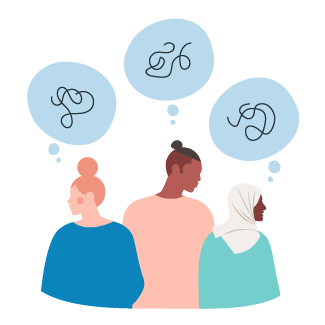What is the first picture that comes to mind, when you think of the word 'Boss'? Or what about 'Nurse'? Or maybe 'Athlete'? Probably, you have thought: Man. Next: Woman. And at last: Man with a lot of muscles, who runs fast. And this is not necessarily what the world looks like.
Even so, prejudices and biases run automatically and unconsciously just under our skin, while, at the same time, the effect of cultural structures are deeply attached, and that is why it can be difficult to see other worlds than our own. This is challenging, when companies want to grow. Because positive growth is driven by innovation, and innovation can be supported with a focus on diversity and inclusion. This is important in the future of work.
What Is Diversity and Inclusion?
Diversity is a combination of all our differences, for example, race, ethnicity, sexuality, educational background, age, culture, and gender. Inclusion is about taking action and steps towards getting all the differences included. It is about creating an environment and culture in the company, which are equal, just, and inclusive, regardless of whatever diversity parameter you share.
"Open your eyes. Diversity is something you see every single day. On the street you see different genders, religious expressions, some uses a stick, and some other characteristics you cannot see like sexuality and educational background, but they are there.
So, diversity is a fact. It is something, we experience every day. Inclusion is the strategic choice you take in a company to ensure, that you have an environment and a culture, where diversity thrives," Helene Aagaard says, CEO and Partner in Diversity Factor.
 Why Is Diversity and Inclusion Important?
Why Is Diversity and Inclusion Important?
Innovation, high performing teams, and positive growth. These are just some of the results, that companies and organizations can achieve by focusing on diversity and inclusion.
In the latest report about D&I from McKinsey & Company (2020) they conclude, that companies in the upper quartile for gender diversity in management teams were 25 percent more likely to have profitability above average than companies in the fourth quartile.
It is an increase from former reports, where the percentages were 21 percent (2017) and 15 percent (2014). For ethnic/cultural diversity the return was even bigger. In 2019 companies in the top quartile outmatched the ones in fourth quartile with 36 percent in profitability, which is an increase too, when you compare with former reports, where the percentages were 33 percent in 2017 and 35 percent in 2015.
"'The Money Argument' is clearly in place when you focus on the positive effects of D&I. But honestly - I am so tired of that argument. Because we all have a responsibility to create a better community and behave in a good manner. This is a rule for companies too. They also have the responsibility to avoid their employees get discriminated."

"People should not fit into a default template, but companies must create an equal and just working environment. The younger generations can, by the way, see it instantly if we are talking about pink washing, black washing, or purple washing. So, if you focus on D&I only to make money, then you cannot retain these generations," Helene Aagaard says.
Stats - D&I
- Diversity corresponds to financial performance, according to McKinsey & Company.
- Organizations with inclusive culture are 2x likely to achieve or exceed financial targets. They are 3x more likely to be high performing. They are 6x more likely to be innovative and agile, and they are 8x more likely to achieve better business outcomes, according to Deloitte Insights and Juliet Bourke.
- 39 % of respondents in a McKinsey study tell, that they have passed on a job offer, because they experienced that the company lacked inclusive culture.
- 54 % of women and 45 % of men in a PwC study tell, that they researched whether a company had D&I-policies, before they accepted a job offer at their most recent employer.
- 35 % of an employee's emotional investment and 20 % of their desire to stay at a company relate to inclusion, according to a Catalyst study.
-
85% of CEOs in organizations with a D&I-strategy say that it has improved the company's bottom line, according to PwCs CEO Survey.
Tips to Create more Diversity and Inclusion
There are a lot of good intentions. And if we go back to the report from McKinsey & Company (2020) it becomes apparent, that even for companies, which are relatively successful in their efforts to ensure an equal gender - and ethnic representation in management teams, they still have huge challenges to create inclusion. Inclusive environments, where each and every employee can go to work without being struck by bias and discrimination.

"To create more diversity and inclusion you must first and foremost take it seriously. We experience, that a lot of companies do employee engagement surveys, where they primarily ask the employee about whether they understand a certain strategy or if they like their manager. It shows, that companies are anxious about knowing what the employee actually thinks about the company. And we must move away from this. We need to take the employees' values and opinions seriously. Because then we can start the real work," Helene Aagaard says and continues:
"You have to make one thing clear: This is a learning journey for an organization. Because when we all walk around with unconscious bias, and when we get confronted with this, it hurts. Especially, if you have a picture of yourself as an inclusive and tolerant person."
"It is about changing behaviors. And it is down to the tiny stuff we do every day: From the conversation at the coffee machine to the big strategic action plans. At the learning journey to change behaviors, we often take two steps forward and one step back, and it is in the step back the learning arises, it is here the reflection is. And then we change behavior and take two steps forward and one step back again."

Here are more tips to create more diversity and inclusion at the workplace:
- Anonymize resumes in a recruitment process. Look at name, age, and address - or choose to anonymize some of the elements. An example could be removing age from a resume at a workplace with a lot of young employees. Or removing the unconscious bias about women in their final 20s or start 30s who might need maternity leave at one point.
- Ask all candidates the same questions at a job interview. Studies show that there is a tendency to ask men more open questions, and, on the contrary, women more closed questions. If you get the opportunity to speak more nuanced and elaborate, the likelihood of getting the job is greater. The world is not black and white or yes and no.
- Language: Practice to say 'chairperson' instead of 'chairman' if you are uncertain what gender the person has. The same goes when you have to write and describe. Here, you can instead mix the use of 'he' and 'she', instead of only typing 'he'. A more inclusive choice of wording is to use 'women' instead of 'girls'. The same goes for groups who often experience to be called 'minorities'. Instead, they prefer 'marginalized'.
- Spend a break with a co-worker you do not know well - yet. Be respectful about other ways of life, and maybe you get wiser yourself and expand your horizon?
- Create learning about D&I for employees and managers, that create awareness to prejudices, privileges, and biases in a gamified, engaging, learning environment, which can kickstart a new culture about diversity and inclusion at the workplace.


